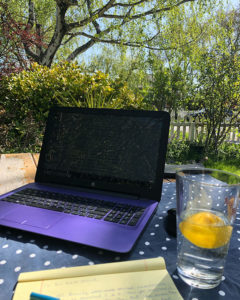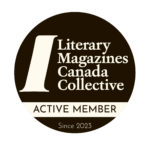Katie Zdybel was the winner of the 2018 Peter Hinchcliffe Fiction Award for her story “The Last Thunderstorm Swim of the Summer” a coming of age story where a teen struggles with her late-blooming sexuality, feeling the weight of the cozy and perhaps stifling upbringing by her single mum, an academic who was more concerned with matters of the mind, and the inadvertent influence of a vivacious family friend they visited over several summers.
This is a story deeply rooted in place, and the characters’ connection to it. Can you talk about how the landscape influenced the development of this story?
Place is very, very important to me, and I find that most of my fiction starts there. I see place as an extension, or realization, of self. A lot of that has to do with colour palette, textures, and shapes — and the emotional resonance of these colours and shapes. I like exploring place in my writing via character, and character via place.
In this story, Ginny is caught between a place where she finds herself with her mother and where she wants to be, with her friend’s mother. Those two different mothers are represented by the nature of the different places (northern Michigan and western Michigan). Particularly, I’m so fascinated by the almost exotic nature of Sleeping Bear Dunes in western Michigan, where most of this story takes place. You don’t think of turquoise waters and white sand beaches when you think of Michigan; it’s an unexpected moment of paradise. I love that surprise pop of tropical colour and lushness in an otherwise pretty urban and industrialized state. And I love how our actions change when we find ourselves in different places. A certain colour palette calls for different moods and actions.
The relationships between Ginny, the teenage daughter and her mother is complex and evolving, one that seems disorienting to both. Can you talk about this relationship that is both fraught and loving?
This story is part of a collection (Equipoise) in which most of the stories involve a mother-daughter relationship. This is probably because I became a mother while writing them. I feel like I picked up that relationship dynamic like a crystal in my hand and just kept turning and turning it over, studying each facet and writing down what I could see, all the little notches and corners, and surprising ways that light is caught or muted in them.
To me, Ginny and her mother Margot have a strong and quite beautiful bond, but Ginny’s at that stage in her life where she needs to create some distance between herself and her mother, almost so that she can see it better, and then decided how deeply she will dive into an adult relationship with her mother — or not.
The way that Ginny and her mother are connected to their family friends is complicated as well. They seem so close, and has been a supportive place for them, but also claustrophobic, perhaps. Why did you want to explore this form of friendship in the mothers and in the daughters?
I don’t generally go into a story consciously wanting to explore one thing or another, but in this case, I actually did want to explore exactly that dynamic: how young women interact with the mothers of their friends. Our friends’ mothers offer an alternative model of a mother or of womanhood to us. When we’re feeling immature or insecure, or when we have a true need, we can idolize other mothers, as Ginny does. I think there’s a feeling of wholeness that can come from seeing the wholeness of your own mother — maybe I’m lucky to be able to say that because the wholeness of my own mother is quite loving, empowering, and inspiring. But still, I remember this kind of curiousity or fascination about how mothering was happening in the families of my friends — the different languages and belief systems my friends were learning from their mothers.
What themes were you interested in exploring in this story?
Ultimately, the story, to me, is about women and their relationships to their sexual bodies. I like that it evolved that the four female characters in this story each have their own approach to this relationship — one is at peace with it, one is perhaps a little afraid, one might use it for power — and Ginny is at this moment in her young adult life where she’s trying to figure out how she wants to shape that relationship for herself. I like that she does this in relation to the women in her life, as opposed to the men.
As a late bloomer, she almost has this extended moment in which to really examine the female body before exploring her own sexual self. She doesn’t quite have the maturity to recognize this yet, but my hope for future Ginny is that she becomes aware of this extra beat in time she’s been given.
Now for a more general question, can you tell us a bit about your writing life, what you’re working on, any rituals in the process, the best advise you’ve ever received.
I’ve just submitted a fresh revision of my short story collection, Equipoise, to my agent (it’s still feels new and miraculous for me to use the words ‘my agent’), and will be focusing some attention on my SSHRC-funded thesis for UBC — a creative non-fiction book titled Cold Dark Joy. I’ll be traveling to Copenhagen soon to do some research for this book about how humans can thrive — and not just survive — in cold, dark landscapes.
All my rituals evaporated when my children were born. I just write when I can, in crowded closets, in bed, at the kitchen counter. If I could have a ritual it would be to meditate before I write, but my schedule doesn’t really allow for rituals at this phase in my life, though I do have faith in rituals. I try to just function in a somewhat meditative, or creativity-ready state as I change diapers, play dinosaurs, grocery shop. I’m about 40% successful at that.
One of the best pieces of advice I ever received came from my oldest sister’s boyfriend when I was probably 15 or 16. We were standing in the garage with the rest of my family, getting out of the rain. He was a writer of some kind and I told him I hoped to be a good writer someday too. He said it wasn’t a matter of being good, but rather a matter of being honest. That was it, and they didn’t date for very long, but I think of this often.
What authors do you like to read? What book or books have had a strong influence on you or your writing?
I am wholly satisfied as a reader when I read Alice Munro. I just keep going back to her again and again. I take a break, then go back. My favourite moments in her writing are the exactness in her descriptions of weird, elusive, uncomfortable, contradictory emotions. I also love Lauren Groff, Annie Dillard, Annie Proulx. Marilynne Robinson’s books have had a profound effect on my understanding of what fiction can do, and of what humans are capable of. They have transformed me so profoundly as a person. The truths of humanity she uncovers are so reassuring and mystifying. Lila is maybe the fictional character I love the most in the world. And John Williams’s Stoner is a perfect novel, in my opinion.
As an emerging writer can you comment on the experience of winning the Peter Hinchcliffe Short Fiction Award?
I was at my mom’s when I read the email and I came running up the stairs and told her I’d won, and I just had this feeling that things were going to change. A week later I learned I’d been shortlisted for the UBC/Harper Collins Prize for Best New Fiction, and a couple months after that I signed with Transatlantic.
I think that, more than anything, knowing the editors at TNQ had faith in my writing made me want to just work all that much harder. I love the feeling of people discussing my work and wanting to talk to me about it. This is fairly new for me outside of a workshop scenario, and it is breathing new life into my writing process. I’m extremely grateful, and I want to give back by producing my best, and most honest, work.


